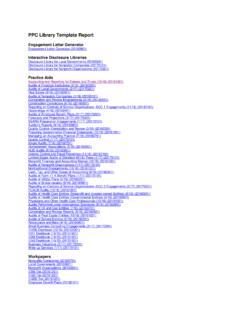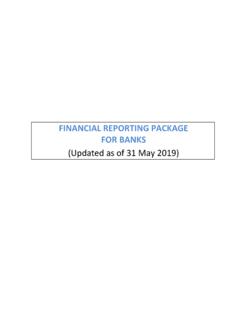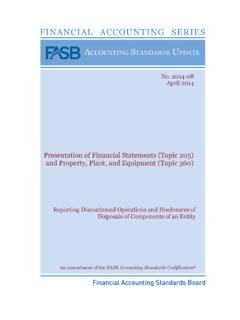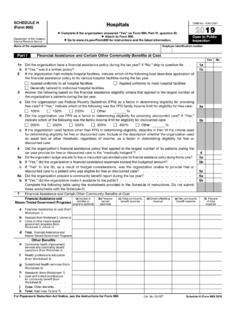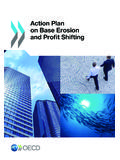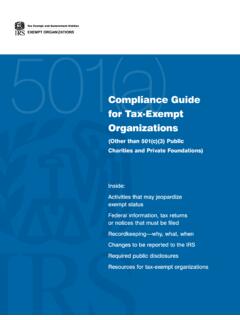Transcription of Not-for-profit financial reporting and tax update - Feb 2018
1 Not-for-profit financial reporting and tax updateFebruary 2018EY | 2 Copyright 2018 Ernst & Young Australia. All Rights Reserved. Liability limited by a scheme approved under Professional Standards LegislationNot-for-profitupdate financial reportingFinancial reporting for Not-for- profits (NFP entities) continues to be an area of focus for the Australian Accounting Standards Board (AASB). We also continue to see developments in taxation law for NFP entities. We outline the latest developments in financial reporting and tax below. Please contact your EY advisor for further Replacement Cost as a Measure of Value in Use Removes references to depreciated replacement cost (DRC) as a measure of value in use in AASB 136 Impairment of Assetsfor NFP entities.
2 Clarifies that the recoverable amount of primarily non-cash generating assets, which are typically specialised assetsand, that are generally held for continuing use of their service potential by NFP entities, should be measured at fair value in accordance with AASB 13 FairValue Measurement. Amending standardAASB 2016-4 Amendments to Australian Accounting Standards Recoverable Amount of Non-Cash-Generating Specialised Assets of Not-for-profit Entities wasissued in June 2016. Effective for annual reporting periods beginning on or after 1 January 2017.
3 No material impact expected. The AASB has noted that the definition ofDRCin AASB 136 and the guidance on current replacement cost in AASB 13 are expected to result in values materially the same, and in practice valuers treat them interchangeably for the specialised assets being considered. Income of NFP entities Income of NFP entities is currently governed by AASB 1004 Contributions. The new standards will defer income recognition in some circumstances for NFP entities, particularly where there is a performance obligation or any other liability.
4 In addition, certain components in an arrangement, such as donations, may be separated from other types of income and recognised immediately. The Standard also expands the circumstances in which NFP entities are required to recognise income for goods and services received for consideration that is significantly less than the fair value of the asset principally to enable the entity to further its objectives (discounted goods and services), including for example, peppercorn leases. AASB 1004 will continue in force but with its scope restricted to specific issues for government entities and contributions by owners.
5 AASB 1058 Income of Not-for-profit Entities and AASB 2016-8 Amendments to Australian Accounting Standards Australian Implementation Guidance for Not-for-profit Entities, and revisedAASB 1004 issued in December 2016. The new and revised standards apply to accounting periods beginning on or after 1 January 2019, and may be early adopted. Depends onhow an NFP entity currently applies AASB 1004. Timing and amount of revenue/grants to be recognised by an NFP entitymay be impacted. Clearer guidance for deferral of revenue from some transactions where sufficiently specific goods/services are promised (referencing the AASB 15 requirements).
6 Peppercorn rent leases have a potentially significant impact in the year the NFP enters the | 3 Copyright 2018 Ernst & Young Australia. All Rights Reserved. Liability limited by a scheme approved under Professional Standards LegislationNot-for-profit update financial reportingDetailStatusImpactStandard Setting Framework The AASB is seeking comment on its proposed Framework for standard setting forAustralian entities, including when modifications to IFRS Standards may be justified. The paper discusses the role of the AASB in setting accounting standards for use by Australian entities that are reporting entities.
7 AASB Invitation to comment 137: Standard setting framework for For-Profit and Not-for-profit Entities was issued in October 2017. Comments closed 17 January 2018 TheFramework provides a basis for AASB modifications to IFRS. Constituents can use the Framework to better formulate and justify requests for changes to AASB performance reporting for NFP entities The purpose of the first stage of this Project is to develop an AASB ED that will propose a Standard on service performance reporting by NFP (including public sector) entities. The ED is based on IPSASB ED 54 reporting Service Performance reporting : Proposed Recommended Practice Guidance, combined with the results of the AASB staff research to date and the work of the NZASB.
8 ED 270 reporting Service Performance Information was issued in August closed 29 April 2016. AASB considering comments. The proposals would require NFP entities to provide information on: Keyservice performance objectives what the entity does to fulfil its purpose Performance indicators -how the entity measures its achievement of those service performance objectives. The proposals do not require this informationto be audited or reviewed but acknowledge this may be required by other in Charity reporting The paper presents arange of illustrative financial reporting frameworks, using various criteria and thresholds Its intention is to promote discussion among stakeholders AASB DiscussionPaper: Improving financial reporting for Australian Charities Potentiallyless complex requirements for reporting in the charity sector.
9 Elimination of duplicate reporting requirements between state and federal level Greater transparency around thresholds for Disclosure Requirements This exposure draft proposes somedisclosure exemptions for Tier 2 reporters in relation to the recently released accounting standards AASB 1058 Income of Not-for-profit Entities, AASB 16 Leases and AASB 1059 Service Concession Arrangements: Grantors. ED 284 Recent Standards Reduced Disclosure Requirements, issued December 2017 Comments requested by 31 March 2018 The proposals willresult in fewer required disclosures for those entities preparing Tier 2 General Purpose financial | 4 Copyright 2018 Ernst & Young Australia.
10 All Rights Reserved. Liability limited by a scheme approved under Professional Standards LegislationNot-for-profit update financial reportingDetailStatusImpactFinancial Instruments(new standard) This standardwas issued in 24 July 2014 and replaces most of the guidance in AASB 139. AASB 9 introduces a new classification model for financial assets that is more principle-based than the current requirements under AASB 139. financial assets are classified according to their contractual cash flow characteristics and the business models under which they are held.







